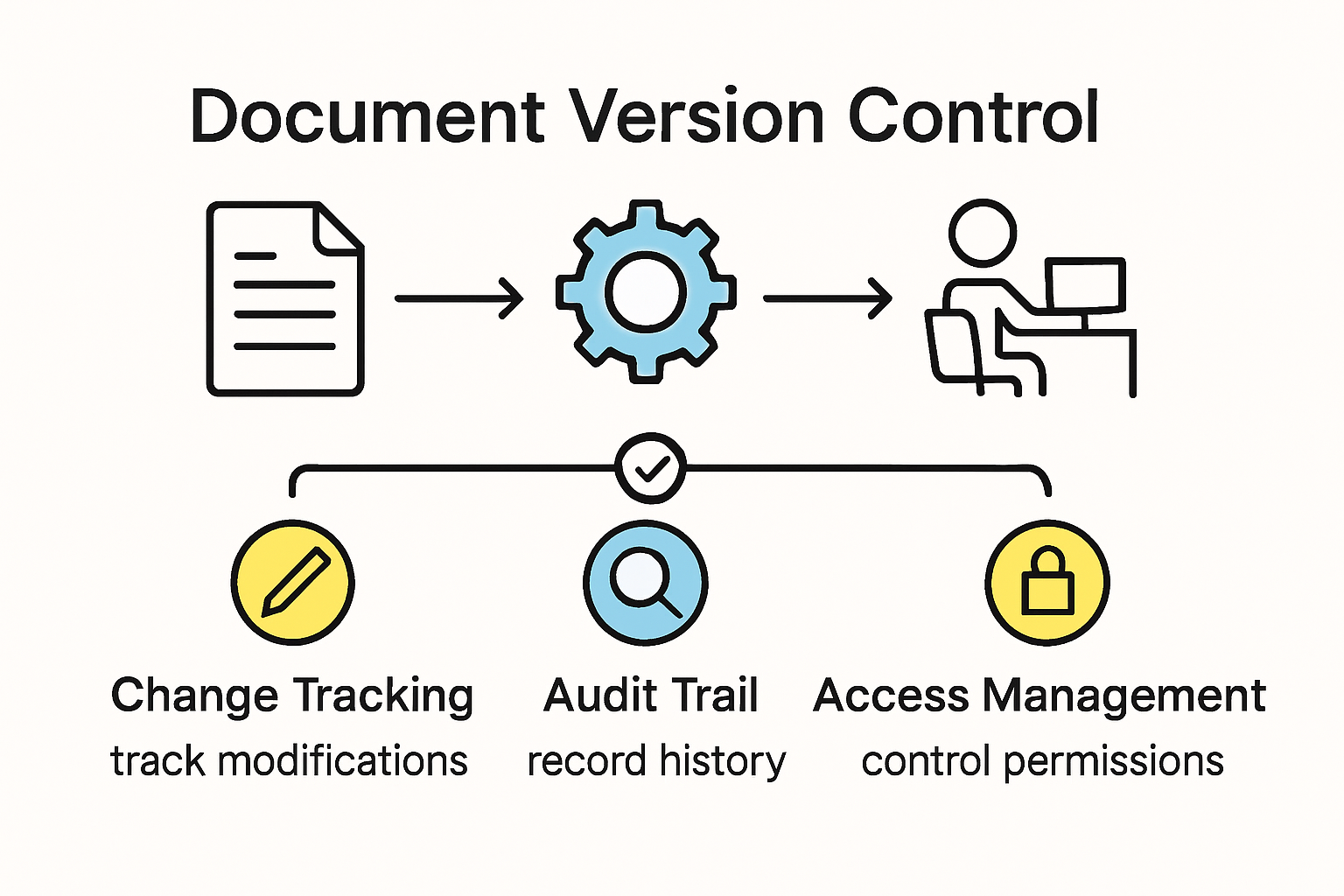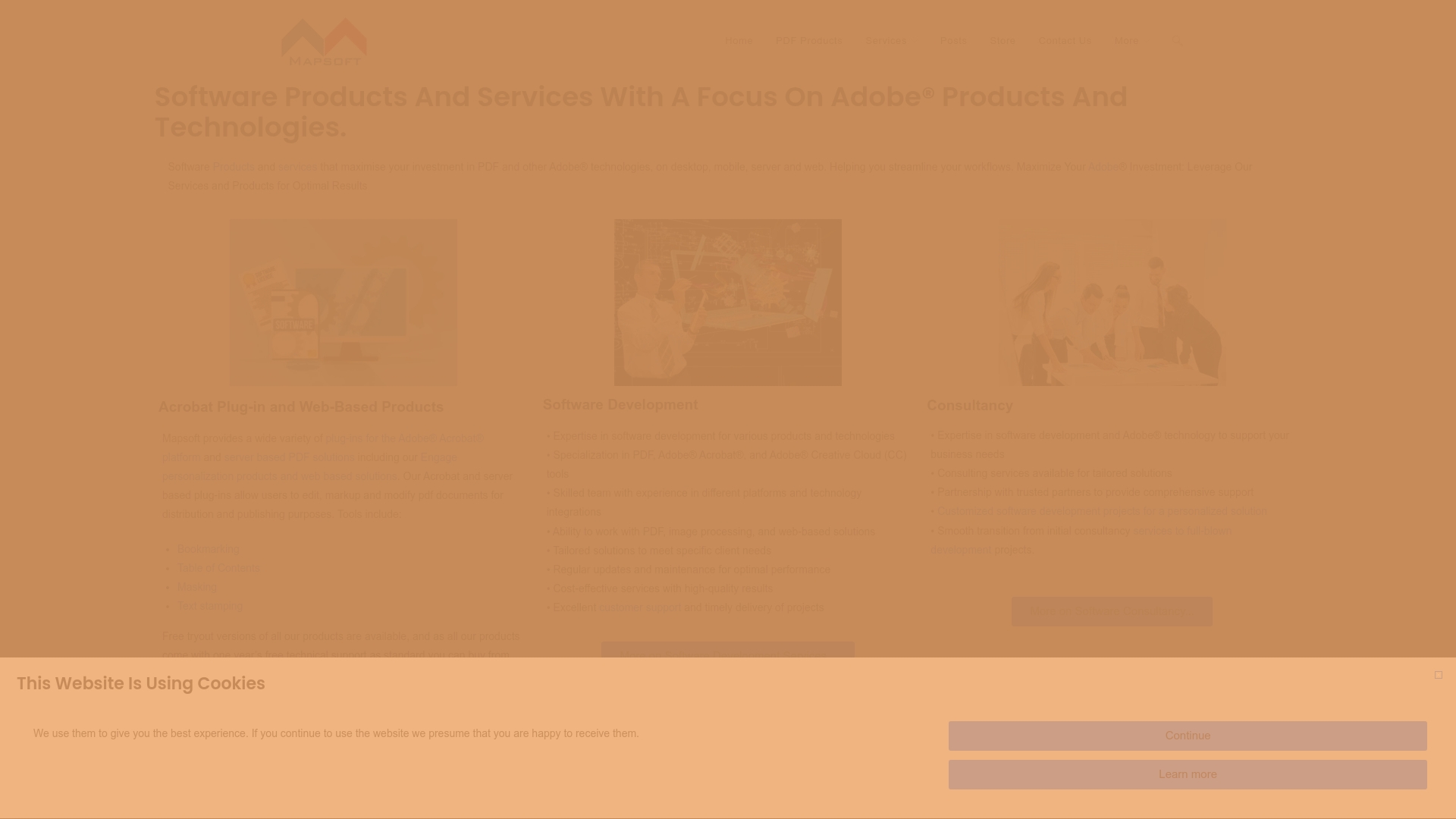Document chaos used to mean missing edits, overwritten files, and endless debates over which version is the real one. But get this. Nearly 90% of businesses now consider automated document version control a must-have for compliance and risk management. Most people think it is just about tracking changes, but it turns out modern systems transform entire workflows, protect sensitive data, and help teams move faster than ever.
Table of Contents
- Why Document Version Control Matters For Businesses
- Key Features Of Effective Document Version Control Systems
- Best Practices For Pdf Version Control With Adobe Solutions
- How To Streamline Document Workflows For It Teams
Quick Summary
| Takeaway | Explanation |
|---|---|
| Document version control is essential for collaboration | It prevents issues like overwriting and confusion about the most current document versions during team collaboration. |
| Compliance requires accurate change tracking | Organizations must maintain an audit trail for regulatory purposes, ensuring document changes are transparent and traceable. |
| Robust security measures protect sensitive documents | Implement strict access controls and encryption to secure documents throughout their lifecycle and mitigate risks. |
| Automated version tracking enhances efficiency | Use systems that automatically track changes and maintain document history to improve workflows and reduce manual errors. |
| Continuous integration streamlines document workflows | Automate document processing and collaboration to enhance team efficiency, reducing bottlenecks in information management. |
Why Document Version Control Matters for Businesses
Document version control represents a critical operational strategy for modern businesses seeking to maintain accuracy, accountability, and efficiency in their information management processes. At its core, document version control allows organizations to track, manage, and preserve the evolution of critical documents throughout their lifecycle.
The Collaborative Imperative of Version Control
Businesses today operate in increasingly complex environments where multiple team members frequently collaborate on the same documents. Research from TechTarget highlights that proper version control offers profound benefits including improved collaboration, clear differentiation between official and draft content, and the ability to reference historical standards.
In practice, this means preventing common pitfalls like accidental overwriting, losing critical edits, or struggling to determine which document iteration represents the most current approved version. When multiple employees work simultaneously, version control becomes not just a convenience, but a necessity for maintaining organizational integrity.
Compliance and Risk Management
According to Box’s enterprise documentation, document version control is crucial for ensuring users consistently access the most current and accurate drafts while simultaneously preserving a comprehensive history of changes. This capability extends far beyond simple record-keeping.
For regulated industries like healthcare, finance, and legal services, maintaining a precise audit trail of document modifications is not optional—it’s a mandatory compliance requirement. Version control systems provide a transparent, chronological record of who made specific changes, when those changes occurred, and the precise nature of those modifications. This level of granular tracking helps organizations mitigate risks, demonstrate regulatory adherence, and quickly resolve potential disputes.
Operational Efficiency and Knowledge Preservation
Research from QI-A indicates that robust version control strategies enable businesses to trace back critical decisions, improve training outcomes, and facilitate smoother cross-departmental collaboration.
By maintaining comprehensive document histories, organizations create valuable institutional knowledge repositories. New team members can understand the evolution of critical documents, comprehend past decision-making processes, and learn from historical context. This approach transforms version control from a technical requirement into a strategic knowledge management tool that supports continuous organizational improvement and learning.
Effective document version control is no longer a luxury—it’s a fundamental requirement for businesses seeking to maintain competitive edge, ensure compliance, and foster a culture of transparent, collaborative information management.
Key Features of Effective Document Version Control Systems

Below is a table summarizing the key features and benefits of effective document version control systems discussed in this section.
| Feature Category | Key Capabilities | Benefits |
|---|---|---|
| Advanced Change Tracking | Timestamp records, user identification, comprehensive change summaries | Enables accountability and transparency |
| Audit Capabilities | File locking, version merging, detailed modification logs | Prevents conflicts and ensures data integrity |
| Collaboration & Access Management | Role-based access, approval workflows, multi-stage review processes | Balances security and collaboration |
| Integration & Automation | Syncing across platforms, real-time notifications, automated backups, cross-platform accessibility | Minimizes manual work and reduces errors |
Document version control systems have evolved into sophisticated platforms that enable businesses to manage complex documentation workflows with precision and efficiency. The most advanced systems go beyond simple file tracking to provide comprehensive document management capabilities.
Advanced Change Tracking and Audit Capabilities
According to Wikipedia’s documentation on version control, modern version control systems offer critical features like file locking to prevent concurrent access issues and sophisticated version merging mechanisms that integrate changes from multiple users seamlessly. These technical capabilities ensure data integrity and enable collaborative environments where multiple team members can work on documents without risking accidental overwrites or conflicting modifications.
Effective tracking goes beyond basic change logs. Advanced systems provide granular insights into document modifications, including:
- Timestamp records showing exact moments of change
- User identification for each modification
- Comprehensive change summaries detailing precise alterations
This level of detailed tracking transforms version control from a simple record-keeping tool into a strategic asset for organizational transparency and accountability.
Collaboration and Access Management
Research on document management best practices emphasizes the importance of establishing robust version control protocols that balance accessibility with security. Effective systems must provide nuanced access controls that allow organizations to:
- Restrict document editing based on user roles and permissions
- Create approval workflows for document changes
- Implement multi-stage review processes
These features ensure that sensitive documents remain protected while still allowing necessary collaborative interactions. By creating structured environments where changes are controlled and documented, businesses can maintain data integrity and compliance.
Integration and Automation Capabilities
The most sophisticated document version control systems transcend traditional file management by offering seamless integration with existing organizational workflows. Modern platforms can automatically:
- Sync documents across multiple platforms
- Generate notifications for critical changes
- Create backup versions during significant modifications
- Enable cross-platform accessibility
These automated features reduce manual administrative overhead and minimize human error. By implementing intelligent version control systems, businesses can create more responsive, adaptive documentation ecosystems that support rapid decision-making and continuous improvement.
The future of document version control lies in systems that are not just reactive record-keepers, but proactive tools that enhance organizational communication, collaboration, and strategic knowledge management.
Best Practices for PDF Version Control with Adobe Solutions
To clarify and compare recommended best practices for PDF version control using Adobe Solutions, the following table organizes the main strategies and their organizational benefits.
| Best Practice | Key Actions | Benefits |
|---|---|---|
| Implement Robust Security Protocols | Set access controls, enable encryption, track user interactions | Protects sensitive data, manages permissions |
| Accessibility & Metadata Management | Use consistent naming, embed version info, maintain change logs | Improves document organization, audit-ready |
| Automated Version Tracking & Compliance | Auto-backups, revision history, cross-platform synchronization | Reduces errors, simplifies compliance |
PDF version control requires strategic approaches that go beyond basic file management. Adobe solutions offer sophisticated tools for organizations seeking to maintain precise document integrity and streamline collaborative workflows.
Implementing Robust Security Protocols
According to Adobe’s official documentation, setting comprehensive security policies is fundamental to effective PDF version control. Organizations can export security settings, manage access permissions, and revoke document access strategically. These protocols ensure that sensitive documents remain protected throughout their lifecycle.
Key security considerations include:
- Granular access controls limiting document modification
- Encryption mechanisms preventing unauthorized viewing
- Tracking user interactions with critical documents
Businesses can learn more about workflow automation techniques to enhance these security implementations.
Accessibility and Metadata Management
Research from the University of Nevada, Reno emphasizes the importance of comprehensive PDF management. This includes setting precise document titles, ensuring proper content tagging, and maintaining clear version metadata.
Effective metadata strategies involve:
- Consistent naming conventions for document versions
- Detailed change logs tracking modifications
- Embedded version information within document properties
Automated Version Tracking and Compliance
Adobe highlights the critical role of automated version control in preventing documentation errors and facilitating seamless collaboration. Modern PDF management requires systems that automatically track changes, preserve document history, and enable quick retrieval of previous iterations.
Advanced organizations implement version control systems that:
- Generate automatic backup copies
- Create comprehensive revision histories
- Support cross-platform document synchronization
By adopting these best practices, businesses can transform PDF document management from a reactive process to a strategic organizational capability. The goal is creating a robust, secure, and efficient documentation ecosystem that supports innovation and maintains regulatory compliance.
How to Streamline Document Workflows for IT Teams
IT teams face increasingly complex document management challenges that demand sophisticated, efficient workflow strategies. Streamlining document processes requires a multifaceted approach that combines technological solutions, strategic planning, and continuous optimization.
Implementing Continuous Integration Practices
Research from academic systematic reviews emphasizes the critical importance of reducing build and test times, increasing visibility of process results, and supporting automated continuous testing. For IT teams, this translates into developing document workflows that minimize manual interventions and maximize automation.
Key strategies for continuous workflow integration include:
- Automated document processing that reduces human error
- Real-time collaboration tools enabling seamless team communication
- Integrated version tracking across multiple platforms
Explore advanced workflow automation techniques to enhance your team’s operational efficiency.
Version Control Best Practices
According to Wikipedia’s comprehensive version control guidelines, effective document management requires specific strategic approaches. These include making small, incremental changes, ensuring code functionality, utilizing smart branching strategies, and maintaining clear documentation of modifications.
Effective version control for IT teams involves:
- Incremental document updates to minimize disruption
- Clear commit messaging for transparent tracking
- Robust branching strategies that support complex project requirements
Digital Workflow Optimization
Adobe’s enterprise solutions showcase remarkable workflow efficiency. For instance, San Diego State University’s HR department dramatically reduced new hire onboarding time by 66% through strategic digital workflow implementation.
Advanced IT teams can optimize their document workflows by:
- Implementing secure digital signature processes
- Integrating cross-platform document management systems
- Creating standardized template libraries for consistent documentation

Successful document workflow streamlining goes beyond technological implementation. It requires a holistic approach that considers team dynamics, organizational culture, and continuous technological adaptation. By embracing flexible, automated solutions, IT teams can transform document management from a potential bottleneck into a strategic organizational advantage.
Frequently Asked Questions
What is document version control and why is it important for businesses?
Document version control is a systematic approach to managing and tracking changes in documents. It is crucial for businesses as it ensures accuracy, accountability, and compliance, especially when multiple team members collaborate on the same files. It helps prevent issues such as overwriting edits and confusion over which version is the most current.
How can Adobe solutions enhance document version control practices?
Adobe solutions provide advanced tools for PDF version control, including robust security protocols, automated version tracking, and effective collaboration features. These tools simplify the process of maintaining document integrity, ensuring compliance, and streamlining workflows, ultimately boosting operational efficiency.
What key features should an effective document version control system have?
An effective document version control system should include advanced change tracking, audit capabilities, collaboration and access management, and integration with other platforms. These features ensure accountability, enhance team collaboration, and minimize manual work, leading to improved document management.
What are the best practices for implementing version control in PDF documents?
Best practices for PDF version control include implementing robust security protocols, managing accessibility and metadata effectively, and utilizing automated version tracking. These practices safeguard sensitive information, ensure compliance, and enhance document organization.
Take Control of Document Versioning With Confidence
Tired of lost edits and confusion over which PDF is the latest? You are not alone. As discussed in our article, businesses in 2025 cannot afford mistakes or gaps in document version control. From strict compliance needs to a demand for seamless collaboration, organizations need smart solutions that prevent errors, protect sensitive data, and automate the PDF processes that matter most.

Mapsoft.com empowers your team to stop worrying about manual version tracking and file chaos. Our advanced tools, like Mapsoft PDF Hub, handle batch PDF conversions, manage document metadata, and automate secure workflows for ultimate accuracy. Discover how our Acrobat plug-ins and custom workflow solutions solve your most complex PDF version control challenges. Make your document management future-proof today. Visit Mapsoft.com or learn more about automating workflow with Adobe Acrobat’s Actions to get started.



